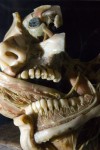 The Wellcome Museum in London is putting on an exhibit of historical anatomical models used to teach in the days before actual human bodies for dissection became legal, widely available and refrigerated, and titillate crowds at carnivals and grotesque museums. Exquisite Bodies features rare pieces in ivory and wood from the 17th and 18th centuries, and layered paper models from anatomy books of that period, but the primary focus are the wax dissection models that became all the rage in the 19th century. Victorian audiences loved them some guts, lumps, lesions and naked ladies, and if they could get all of them in one then that was certainly worth the price of admission.
The Wellcome Museum in London is putting on an exhibit of historical anatomical models used to teach in the days before actual human bodies for dissection became legal, widely available and refrigerated, and titillate crowds at carnivals and grotesque museums. Exquisite Bodies features rare pieces in ivory and wood from the 17th and 18th centuries, and layered paper models from anatomy books of that period, but the primary focus are the wax dissection models that became all the rage in the 19th century. Victorian audiences loved them some guts, lumps, lesions and naked ladies, and if they could get all of them in one then that was certainly worth the price of admission.
Many of these museums and their exhibits were destroyed by police and the suddenly appalled, so many of the pieces on display are extremely rare. Some of them were collected in the early 20th century by Henry Wellcome, founder of the trust that operates the museum; some of them come from private collections around Europe. Many of the most fabulously lurid pieces are from the Roca Museum in Barcelona which survived in the red-light district of that city until 1935.
Especially arresting are supine naked women, known as “anatomical Venuses”, made from the 18th century onwards. They were constructed of wax, wood or ivory so that their stomachs could be opened and internal organs displayed, usually including a pregnant uterus. Most have beautiful faces resembling traditional images of the Madonna, and luxuriant real hair. Although originally modelled for private collections, when any scholarly gentleman’s study would include scientific instruments and anatomical treatises, some were also made to educate medical students. […]
Draw aside the crimson velvet curtains of the side alcoves, and you expose ever more striking things: human genitalia in extreme stages of disease modelled in flesh-coloured wax featuring real pubic hair, for instance. Whether these are intended to terrify the viewer into virtuous living or offer a curious form of titillation is open to debate.
 Oh, I’m quite sure we’re capable of both at the same time. There’s a great deal of artistry involved in some of these models. Joseph Towne was a famous model maker who created highly detailed wax dissection models for Guy’s Hospital his whole life. He won awards for his remarkably realistic, genuinely tragic characters — see the dissected baby brains on the right, for example — and his paranoia was legendary. He stuffed wax in the keyhole of his basement workshop so nobody could steal his prize wax coloring technique.
Oh, I’m quite sure we’re capable of both at the same time. There’s a great deal of artistry involved in some of these models. Joseph Towne was a famous model maker who created highly detailed wax dissection models for Guy’s Hospital his whole life. He won awards for his remarkably realistic, genuinely tragic characters — see the dissected baby brains on the right, for example — and his paranoia was legendary. He stuffed wax in the keyhole of his basement workshop so nobody could steal his prize wax coloring technique.
For a anatomically correct and disturbingly graphic (syphilis lesions eating away at people’s faces, for instance) slideshow of the exhibit, click here. For a curator-guided tour of the exhibit, watch the video below.